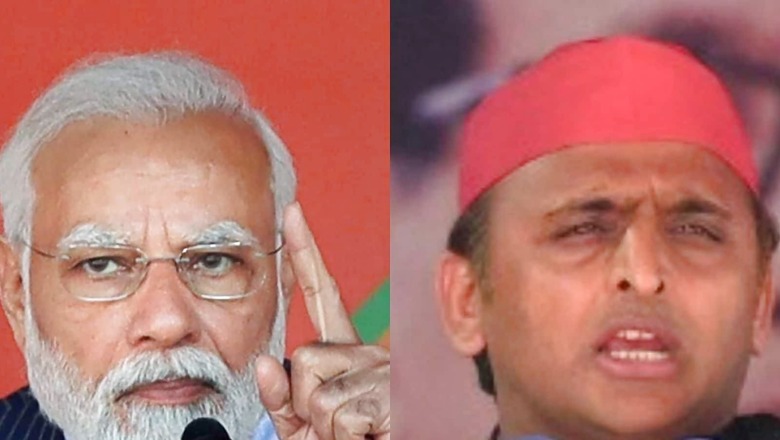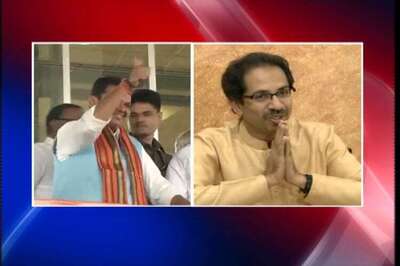
views
As the seven-phase Uttar Pradesh elections enters its final leg, the 54 remaining assembly constituencies across nine districts of Varanasi, Mirzapur and Azamgarh divisions are likely to face a fierce contest between the ruling Bharatiya Janata Party (BJP) and its arch rival Samajwadi Party (SP).
While the BJP hopes to continue its dominance, the SP aspires to not only defend its stronghold of Azamgarh, but also expand its influence across the region. For both the BJP and the SP, a lot will however depend upon how their allies perform in this phase and the larger mood of the most backward communities.
The constituencies that go to polls are Atraulia, Gopalpur, Sagadi, Mubarakpur, Azamgarh, Nizamabad, Phulpur-Powai, Deedarganj, Lalganj (SC), Mehnagar (SC), Madhuban, Ghosi, Muhammadabad-Gohna (SC),Mau, Badlapur, Shahganj, Ghazipur, Jangipur, Zahurabad, Mohammedabad, Zamania, Mughalsarai, Sakaldiha, Saidaraja, Chakia (SC), Pindra, Ajgara (SC), Shivpur, Rohaniya, Varanasi North, Varanasi South, Varanasi Cantonment, Sevapuri, Bhadohi, Gyanpur, Aurai (SC), Chanbe (SC), Mirzapur, Majhawan, Chunar, Madihan, Ghorawal, Robertsganj, Obra (ST) and Duddhi (ST). Of these, 11 seats are reserved for scheduled castes and 2 for scheduled tribes.
In the 2017 assembly elections, 29 of these 54 seats were won by the BJP and seven by its allies. The SP was victorious on 11 seats and six were won by the BSP. In the 2012 elections, the SP had won 34, Bahujan Samaj Party (BSP) seven and BJP just four of them. Three seats were won by the Congress and five by other smaller parties.
The last remaining belt of East Uttar Pradesh that goes to poll on March 7 is marked by some interesting aspects, both in terms of the existing politics and larger demographic realities.
In the capacity of being the Member of Parliament from Varanasi, Prime Minister Narendra Modi has been probably the single biggest influence in the region since the 2014 general election. The party’s performance in the region is also linked to the impact of ‘Brand Modi’.
The PM’s personal connection with Varanasi, along with his larger Hindutva and backward caste identity, has worked well for the BJP in 2017. It, however, still faced some tough challenges from the larger SP-BSP alliance in 2019 Lok Sabha polls. The Dalit-OBC caste alliance of BSP-SP was most successful in this belt. The BSP had won Gazipur, Ghosi, Jaunpur and Lalganj parliamentary constituencies, while SP chief Akhilesh Yadav had won from Azamgarh.
The 2019 Lok Sabha poll results are a reminder of the strategic importance of the lower castes, especially the most backward ones in the region. No surprise that it was in this very area where two Lok Sabha seats of Robertsganj and Mirzapur were also won by the Kurmi-OBC based Apna Dal (S), which had contested the polls in alliance with the BJP. Apna Dal president Anupriya Patel, who is also a minister in the Modi cabinet, is still firmly with the BJP in the battle of 2022 assembly polls.
THE ALLY FACTOR
In the 2017 assembly elections, a big factor behind the BJP’s expansion in this belt was its allies, Apna Dal and Suheldev Bhartiya Samaj Party (SBSP). They had brought in the much-needed crucial support of the Kurmi and the Rajbhar backward castes. The Om Prakash Rajbhar-led SBSP had also won three seats and Apna Dal had got four seats.
The Nishad party that has contested independently outside the NDA fold had also won one seat. This Nishad backward caste-based regional party is now with the BJP and has three candidates in the seventh phase.
The BJP’s challenge has, however, been increased by the SBSP walking out of its fold and now being firmly with the SP. Rajbhar, who was also made a minister in the Yogi Adityanath cabinet in 2017, later parted ways and at present is one of the most vocal critics of the BJP, among the non-Yadav OBC leadership.
The Rajbhar community has a strong presence in districts across Azamgarh, Mau and Varanasi. The SBSP, in alliance with the SP, is contesting 17 seats across the state, of which eight are in this final phase. The SP leadership hopes that Rajbhars, along with a strong presence of Yadav-OBC in this region, can give it the much-needed leverage in its favour.
Even as the BJP gears to deal with the Rajbhar challenge, there is also an intense fight for the influential Kurmi vote bank in this last phase. The SP is trying to dent this community through its alliance with the breakaway faction of the Apna Dal, Apna Dal (Kamerawadi), led by Union cabinet minister Anupriya Patel’s mother Krishna Patel.
While Apna Dal (S) is contesting four seats, the other faction is contesting five seats in alliance with the SP in the final phase. Although the fight between the mother and daughter for the political legacy is not new, it is for the first time that the Krishna Patel faction is contesting an assembly election in alliance with any major political player.
No doubt, both for the BJP and the SP, it’s the “ally factor” that is of huge importance in this final leg of the contest. A lot will depend upon the impact these smaller players can make.
BJP FORTRESS, SP STRONGHOLD
It was in December last year that Prime Minister Modi marked a new beginning for the ancient city of Varanasi, by inaugurating the grand new Kashi Vishwanath temple corridor. Two months down the line, the BJP will surely hope that the corridor will also be the much-needed Hindutva glue cutting across caste fault lines, in the last and also the bitterly contested last phase.
Since 2014, after Modi became the MP from Varanasi, his impact has been strong and almost unchallenged in seven constituencies of the district. In 2012, the BJP had won just three of them, while two were won by the SP and one each by the BSP and Apna Dal (S). In 2017, the BJP, along with its allies, had swept all seven seats, five were won by BJP and one each by Apna Dal and SBSP.
The Modi factor along with favourable caste equations was also vital on other 12 seats across Mirzapur, Sonbhadra and Sant Ravidas Nagar districts. The BJP had won four of the five seats in Mirzapur and its ally Apna dal had won the fifth one. They together won all four seats in Sonbhadra that has two reserved constituencies and two of the three in Sant Ravidas Nagar.
In the 2019 general election too, the BJP and Apna Dal alliance dominated in this area. Varanasi was won by Modi himself, while Robertsganj and Mirzapur were won by its ally.
However, in districts of Jaunpur, Gazipur and Chanduli, which also fall in Varanasi division, the BJP had met with partial success in 2017. It won four of the nine seats in Jaunpur, three of the seven seats in Gazipur and four of the five in Chanduli. Despite a saffron tsunami and no significant caste-based alliance, the SP had won three seats in Jaunpur, two in Gazipur and one in Chandauli. The SP will now surely hope to recreate the 2012 magic, when it had won seven seats in Jaunpur and six in Gazipuir.
The biggest challenge that the BJP faced in the 2017 election, despite a massive wave, was in Azamgarh. The Muslim and Yadav OBC dominated district had been the strongest fortress for the SP. It had won five of the 10 assembly constituencies. Four had gone to the BSP, while just one was won by the BJP. In 2012, the BJP was nowhere in the scene itself. The SP had then won nine and BSP one.
The SP is once again banking on its tried and tested Muslim Yadav (MY) equation. One that seems to be more cemented behind the party this time around. In neighbouring Mau, eyes will also be on the Mukhtar Ansari factor, the sitting MLA, who has been projected by the BJP as the biggest symbol of organised crime and Mafia in the state.
Currently in jail, Mukhtar himself is not in the electoral race, it is his son, Abbas, who is contesting from the family bastion of Mau Sadar on an SBSP ticket. The SP hopes that along with the Rajbhar factor and the Ansari family’s clout, Mau will be regained. In 2017, the BJP had won three of the four seats in the district.
Read all the Latest Politics News and Breaking News here















Comments
0 comment